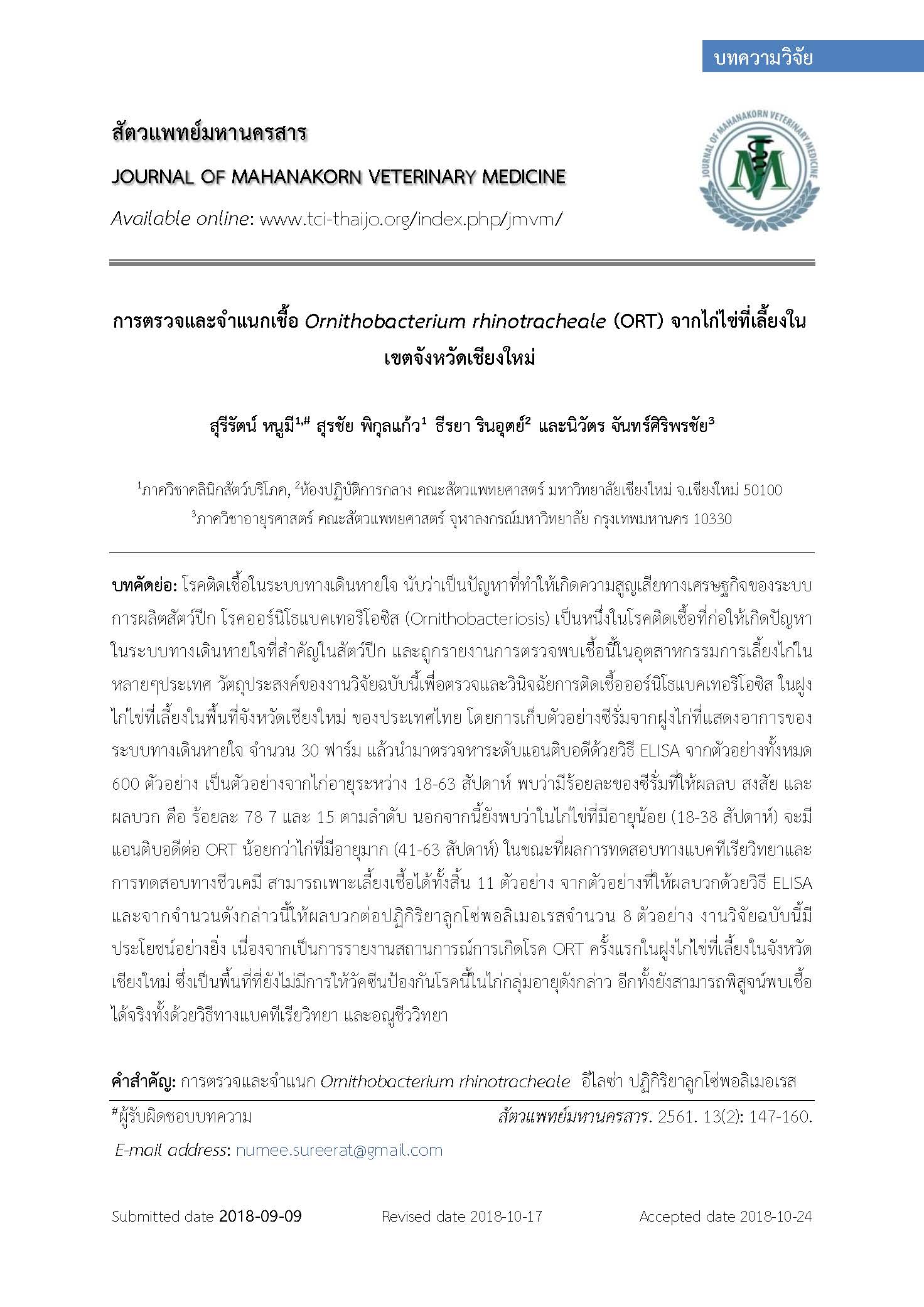การตรวจและจำแนกเชื้อ Ornithobacterium rhinotracheale (ORT) จากไก่ไข่ที่เลี้ยงในเขตจังหวัดเชียงใหม่
Main Article Content
บทคัดย่อ
โรคติดเชื้อในระบบทางเดินหายใจ นับว่าเป็นปัญหาที่ทำให้เกิดความสูญเสียทางเศรษฐกิจของระบบการผลิตสัตว์ปีก โรคออร์นิโธแบคเทอริโอซิส (Ornithobacteriosis) เป็นหนึ่งในโรคติดเชื้อที่ก่อให้เกิดปัญหาในระบบทางเดินหายใจที่สำคัญในสัตว์ปีก และถูกรายงานการตรวจพบเชื้อนี้ในอุตสาหกรรมการเลี้ยงไก่ในหลายๆประเทศ วัตถุประสงค์ของงานวิจัยฉบับนี้เพื่อตรวจและวินิจฉัยการติดเชื้อออร์นิโธแบคเทอริโอซิส ในฝูงไก่ไข่ที่เลี้ยงในพื้นที่จังหวัดเชียงใหม่ ของประเทศไทย โดยการเก็บตัวอย่างซีรั่มจากฝูงไก่ที่แสดงอาการของระบบทางเดินหายใจ จำนวน 30 ฟาร์ม แล้วนำมาตรวจหาระดับแอนติบอดีด้วยวิธี ELISA จากตัวอย่างทั้งหมด 600 ตัวอย่าง เป็นตัวอย่างจากไก่อายุระหว่าง 18-63 สัปดาห์ พบว่ามีร้อยละของซีรั่มที่ให้ผลลบ สงสัย และผลบวก คือ ร้อยละ 78 7 และ 15 ตามลำดับ นอกจากนี้ยังพบว่าในไก่ไข่ที่มีอายุน้อย (18-38 สัปดาห์) จะมีแอนติบอดีต่อ ORT น้อยกว่าไก่ที่มีอายุมาก (41-63 สัปดาห์) ในขณะที่ผลการทดสอบทางแบคทีเรียวิทยาและการทดสอบทางชีวเคมี สามารถเพาะเลี้ยงเชื้อได้ทั้งสิ้น 11 ตัวอย่าง จากตัวอย่างที่ให้ผลบวกด้วยวิธี ELISA และจากจำนวนดังกล่าวนี้ให้ผลบวกต่อปฏิกิริยาลูกโซ่พอลิเมอเรสจำนวน 8 ตัวอย่าง งานวิจัยฉบับนี้มีประโยชน์อย่างยิ่ง เนื่องจากเป็นการรายงานสถานการณ์การเกิดโรค ORT ครั้งแรกในฝูงไก่ไข่ที่เลี้ยงในจังหวัดเชียงใหม่ ซึ่งเป็นพื้นที่ที่ยังไม่มีการให้วัคซีนป้องกันโรคนี้ในไก่กลุ่มอายุดังกล่าว อีกทั้งยังสามารถพิสูจน์พบเชื้อได้จริงทั้งด้วยวิธีทางแบคทีเรียวิทยา และอณูชีววิทยา
Article Details
เอกสารอ้างอิง
Bock, R., P. Freidlin, M. Manoim, A. Inbar, A. Frommer, P. Vandamme and P. Wilding. 1997. Ornithobacterium rhinotracheale (ORT) associated with a new turkey respiratory tract infectious agent in Israel. Proceedings of the 11th International Congress of the World Veterinary Poultry Association, Budapest. 120 p.
Bragg, R., J. Greyling and J. Verschoor. 1997. Isolation and identification of NAD-independent bacteria from chickens with symptoms of infectious coryza. Avian Path. 26:595-606.
Canal, C.W., J.A. Leão, D.J. Ferreira, M. Macagnan, C.T.P. Salle and A. Back. 2003. Prevalence of antibodies against Ornithobacterium rhinotracheale in broilers and breeders in Southern Brazil. Avian Dis. 47:163-169.
Canal, C.W., S.L.S. Rocha, J.A. Leão, L.C.B. Fallavena, S.D. Oliveira and N. Beltrão. 2003a. Polymerase Chain Reaction (PCR) detection of Ornithobacterium rhinotracheale (ORT). Cienc. Rural. 33:371-373.
Canal, C.W., J, A. Leão, S.L.S. Rocha, M. Macagnan, C.A.V. Lima-Rosa, S.D. Oliveira and A. Back. 2005. Isolation and characterization of Ornithobacterium rhinotracheale from chickens in Brazil. Res. Vet. Sci. 78(3):225-230.
Chansiripornchai, N. and J. Sasipreeyajan. 2002. Efficacy of sarafloxacin in broliers after experimental infection with Escherichia coli. Vet. Res. Comm. 26(4): 255-262.
Chansiripornchai, N., W. Wanasawaeng and J. Sasipreeyajan. 2007. Seroprevalence and identification of Ornithobacterium rhinotracheale from broiler and broiler breeder flocks in Thailand. Avian Dis. 51:777-780.
Charlton, B.R., S.E. Channing-Santiago, A.A. Bickford, C.J. Cardona, R.P. Chin, G.L. Cooper, R. Droual, J.S. Jeffrey, C.U. Meteyer, H.L. Shivaprasad and R. Walker. 1993. Preliminary characterization of a pleomorphic gram-negative-rod associated with avian respiratory disease. J. Vet. Diagn. Invest. 5:47-51.
Chin, R. and R. Droual. 1997. Ornithobacterium rhinotracheale infection. In: Disease of Poultry 10th ed., B.W.Calnek (ed.) Ames: Iowa State University Press. 1012-1015.
Chu, J., Q. Zhang, Z. Zuo, S. El-Ashram, Y. Guo, P. Zhao, S. Huang, C. He and A. Khan. 2017. Co-infection of Chlamydia psittaci with H9N2, ORT and Aspergillus fumigatus contributes to severe pneumonia and high mortality in SPF chickens. Sci. Rep. 7(1):13997.
De Boeck, C., I. Kalmar, A. Dumont and D. Vanrompay. 2015. Longitudinal monitoring for respiratory pathogens in broiler chickens reveals co-infection of Chlamydia psittaci and Ornitho bacterium rhinotracheale. J. Med. Microbiol. 64(5):565-74.
Devruese, L.A., J. Hommez, P. Vandamme, K. Kersters and F. Haesebrouck. 1995. In vitro antibiotic sensitivity of Ornithobacterium rhinotracheale strains from poultry and zild birds. Vet. Rec. 137:435-436.
El-Sukhon, S.N., A. Musa, M. Al-Attar. 2002. Studies on the bacterial etiology of airsacculitis of broilers in northern and middle Jordan with special reference to Escherichea coli, Ornithobacterium rhinotracheale and Bordetella avium. Avian Dis. 46: 605–612.
Hafez, H.M. 2002. Diagnosis of Ornitho bacterium rhinotracheale. Int. J. Poult. Sci. 1(5):114-118.
Hafez, H.M. and W. Beyer. 1997. Preliminary investigation on Ornithobacterium rhinotracheale “ORT” isolates using PCR fingerprints. In: Proceedings XIth International Conference of World Veterinary Poultry Association. Budapest. 51 p.
Hafez, H.M. and R. Sting. 1996. Serological surveillance on Ornithobacterium rhinotracheale in poultry flock using self/made ELISA. In: Proceedings of the 24th Western Poultry Disease Conference, Cancun. 163-164 p.
Hafez, H.M. and R. Sting. 1999. Investigations on different Ornithobacterium rhinotracheale “ORT” isolates. Avian Dis. 34:1–7.
Hinz, K.H., C. Blome and M. Ryll. 1994. Acute exudative pneumonia and airsacculitis associated with Ornithobacterium rhinotracheale in turkeys. Vet. Rec. 135:233-234.
Numee, S., R. Hauck and H.M. Hafez. 2012. Detection and typing of Ornithobacterium rhinotracheale from German poultry flocks. Avian Dis. 56(4):654-658.
Pan, Q., A. Liu, F. Zhang, Y. Ling, C. Ou, N. Hou and C. He. 2012. Co-infection of broilers with Ornithobacterium rhinotracheale and H9N2 avian influenza virus. BMC Vet Res 8:104.
Roepke, D. C., A. Back, D.P. Shaw, K.V. Nagaraja, S.J. Sprenger, and D.A. Halvorson. 1998. Isolation and identification of Ornithobacterium rhinotracheale from commercial turkey flocks in the upper midwest. Avian Dis. 42:219-221.
Szabó, R., E. Wehmann, L. Makrai, C. Nemes, É. Gyuris, Á. Thuma and T. Magyar. 2017. Characterization of Ornithobacterium rhinotracheale field isolates from Hungary. Avian Pathol. 46(5):506-514.
Vandamme, P., P. Segers, M. Vancanneyt, K. van Hove, R. Mutters, and J. Hommez, F. Dewhirst, B. Paster, K. Kersters and E. Falsen. 1994. Ornithobacterium rhinotracheale gen. nov., sp. Nov., isolation from the avian respiratory tract. Int. J. Syst. Bacteriol. 44:24-37.
van Beek, P., P. van Empel, G. van den Bosch, P. K. Storm, J. H. Bongers and J. H. du Preez. 1994. Respiratory problems, growth retardation and arthritis in turkeys and broilers caused by a Pasteurella-like organism: Ornitho bacterium rhinotracheale or Taxon 28. Tijdschr. Diergeneeskd. 119:99–101.
van Empel, P., H. van den Bosch, P. Loeffen and P. Storm. 1997. Identification and Serotyping of Ornithobacterium rhinotracheale. J. Clin. Microbiol. 35:418-421.
van Empel, P. and H.M. Hafez. 1999. Ornithobacterium rhinotracheale: a review. Avian Path. 28:217-222.
van Empel, P., M. Vrijenhoek, D. Goovaerts and H. van den Bosch. 1999. Immunohistochemical and serological investigation of experimental Ornitho bacterium rhinotracheale infection in chickens. Avian Path. 25:187-193.
van Veen, L., P. van Empel and T. Fabri. 2000. Ornithobacterium rhinotracheale, a primary pathogen in broilers. Avian Dis. 44:896-900.
Zuo Z., T.Y. Zhang, Y.X. Guo, J. Chu, G.G. Qu, L.Z. Miao, Z.Q. Shen and C. He. 2018. Serosurvey of avian metapneumovirus, Orithobacterium rhinotracheale, and Chlamydia psittaci and their potential association with avian airsacculitis. Biomed. Environ. Sci. 31(5):403-406.


